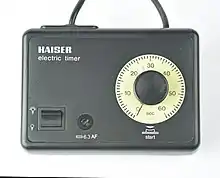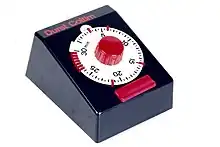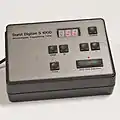Photo-lab timer
A photo-lab timer, photo interval timer, or darkroom timer is a device used in photography for timing the processes of enlarging negatives on paper,making them at any scale. It is a device to which the photo lab enlarger is attached to ensure that the duration of photo exposures on sensitive paper can be carried out accurately.When the selected time has elapsed, the enlarger is switched off or an alarm is sounded, for the photographer to turn it off.

Initially they were conventional clocks but, in a progressive way, they were replaced by wonderful electromechanical timers, until ended being substituted entirely by electronic equipment.[2]
Operation
After specifying a period of time, the supply of power to the enlarger is activated at the push of a button for the desired duration , thus carrying out an exact timing for the exposure. The selectable time range is typically from 1/10th of a second to one or more minutes. Most exposure timers also have a continuous light switch, which is especially helpful for framing and focusing. Depending on the version, the desired duty cycle is set by means of a mechanical dial with scale or a push-button arrangement along with a numerical display. More convenient variants allow the preselection of several timings, which can be called back, specifically from each memory, at the touch of a button.
Mechanical

Clock for mechanical use to measure time. Manual timers are usually set by turning a dial to the desired time interval, turning the dial stores energy in a mainspring that operates the mechanism. They work in a way similar to a mechanical alarm clock, the energy of the mainspring causes a balance wheel to turn backwards and forward.
Each turn of the wheel frees the gear train to advance a small, fixed amount, causing the dial to move steadily back until it reaches zero and the enlarger is switched off or a lever arm strikes a bell.The mechanical enlarger timer was invented in the 1920s with a stabilizer that rotates bein slowed down by the air resistance.[3]
Electromechanical
Short period electromechanical timers for enlargers use a mechanism driven by an AC synchronous motor without any electronic circuitry at all. When the selected time has elapsed, the enlarger is disconnected by means of the relay that kept it on.[6]
The electric current feeds the synchronous motor which drives a demultiplying gear that rotates the "seconds hand" one turn every minute and simultaneously, the "minutes hand" one turn every hour, thus achieving timings of up to 60 minutes with an accuracy of a tenth of a second.[7]
Electronic

Electronic timers are essentially quartz clocks with special electronics and can achieve higher accuracy than mechanical or electromechanical timers. Electronic timers have digital electronics, but they normaly have an analog or digital display.[8]
Integrated circuits have made digital logic so cheap that an electronic timer is now less expensive than the classical mechanical or electromechanical timers. Individual timers are implemented as a simple single-chip computer system, similar to a clock and usually using the same, mass-produced technology.
Automatic timer/analyzer

There is a type of automatic timer manufactured by Kaiser, Philips, and others that by means of a photoelectric sensor (like the one in the photo or mounted inside the easel), is capable of regulating the exposure time according to the light projected by the enlarger, through the negative, on the sensitive paper, magnitude inversaly proportional to the darkness of the negative and its the distance to the paper.[9]
Automatic enlarger timer "Switch and exposure meter for B/W and color negatives and slides. Selective or integral exposure measurement using an independent metering head with a silicon optical sensor and converging lens. Three digits, display amber digital. Start button preparation screen. Time step in the time cycle with countdown to zero. Button to stop and resume the countdown of the remaining running time as well as refraction measurement with direct time reset. It can also be used as a manual exposure timer with setting the desired time using the up/down buttons.[9]
Gallery
.jpg.webp) Agfa timer
Agfa timer Fotothek Technische Werkstätten
Fotothek Technische Werkstätten Durst-digitim
Durst-digitim Electronic Timer and Analyzer
Electronic Timer and Analyzer
References
- Rao, J. (2014). QRS for BDS 4th Year - E-Book: Oral Medicine and Radiology. Elsevier Health Sciences. p. 239. ISBN 978-81-312-3864-6. Retrieved 2023-04-22.
- Sobey, Ed (2021). The Way Kitchens Work: The Science Behind the Microwave, Teflon Pan, Garbage Disposal, and More. UK: Chicago Review Press. pp. 161–164. ISBN 978-1569762813.
- "GraLab Model 300 Electro-Mechanical Darkroom Timer GR300 B&H". bhphotovideo.com. 2022-06-03. Retrieved 2023-04-21.
- "Laboratory Timers, Scientific, Laboratory Timers". Electric Timers by GraLab - Trusted, Proven Electronic and Electromechanical Timing Devices. Retrieved 2023-04-21.
- Ground Cameras and Photo Lab Equipment. U.S. Air Force. 1964. p. 3-112. Retrieved 2023-04-21.
- "The Ideal Darkroom Timer for All Enlarging, Developing and Color Photo Processing: Gerlab Model 300". 2023-04-21. Archived from the original on 2023-04-21. Retrieved 2023-04-21 – via ebayimg.com.
- DeMaio, J.; Worth, R.; Curtin, D. (1997). The New Darkroom Handbook. Taylor & Francis. p. 430. ISBN 978-1-136-09197-1. Retrieved 2023-04-22.
- "Ausschnitt aus Foto-Kaiser Katalog: Elektronische Belichtungsschaltuhr 'Automatic Timer cpd'" [Excerpt from the Foto-Kaiser catalogue: Electronic exposure timer 'Automatic Timer cpd'] (in German). Retrieved 2023-04-18 – via ebayimg.com.
External links
- "Darkroom Process control / Timers". fotoimpex.com analogue photography. Retrieved 2023-04-21.
